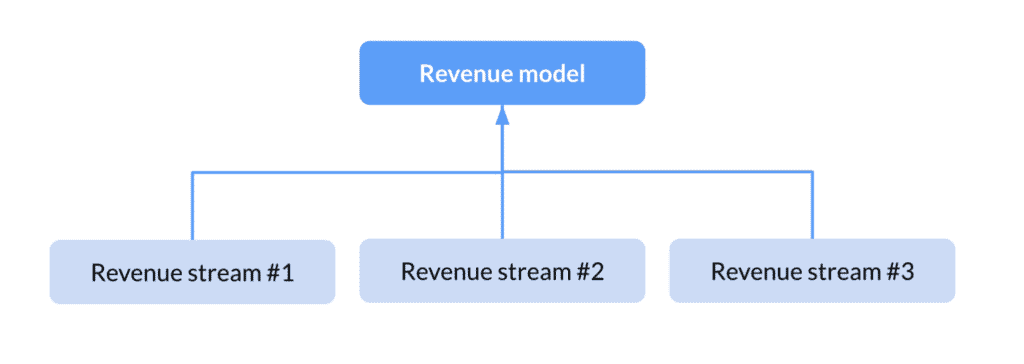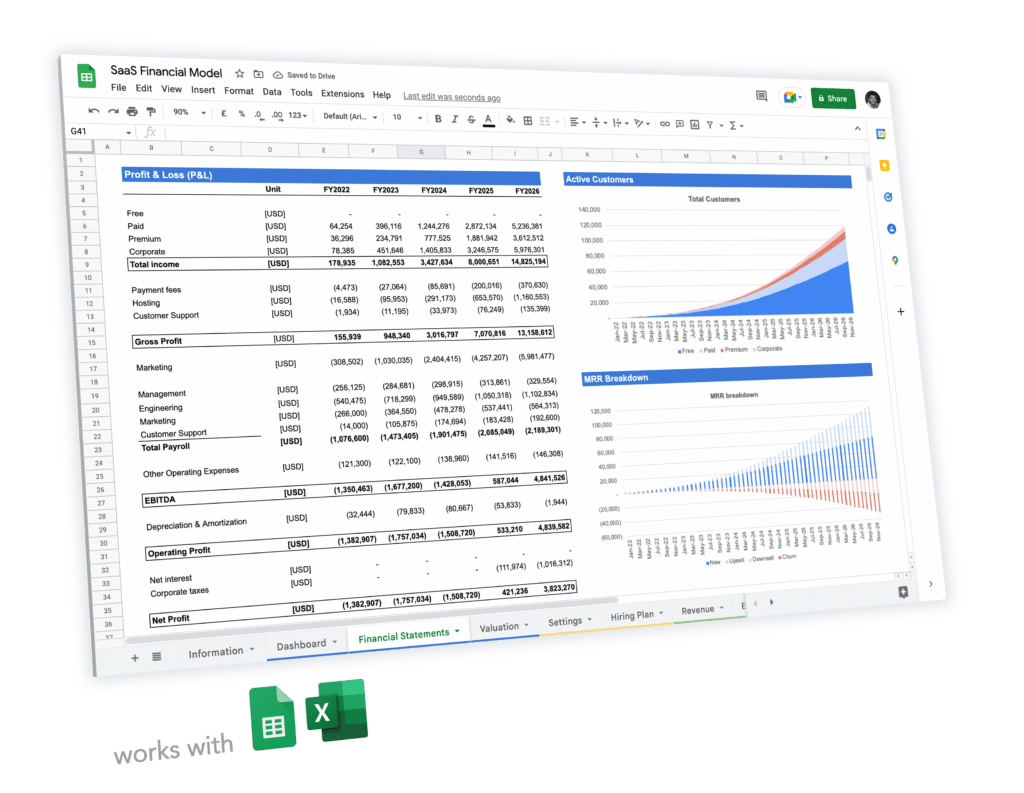8 Most Popular Startup Revenue Models Explained

There have different ways to earn revenue. A business’ revenue model is very important as it is a component of its business model: which product/services it sells to whom and how.
You might haven’t yet decided which revenue model to opt for. Or you might simply be wondering which is one is best for your business. In this article we explain you what are the 8 revenue models and their pros and cons. Read on.
What is a revenue model?
A revenue model defines how a business generates revenue. For instance, a clothing shop sells clothes to its customers for a one-time fixed payment. Instead, Netflix charges its customers a recurring fee, every month, so they can continue watching content on their platform. Both companies make money, yet differently.
Revenue model vs. revenue stream

You might have heard of revenue stream (instead of revenue model). Whilst both terms are similar, they don’t exactly mean the same thing:
- Revenue model: how a business generates revenue
- Revenue stream: a business’ source of revenue
For instance, while a business might have a subscription revenue model, it might have 2 different revenue streams: subscription “Premium” and “Corporate”.
Instead, the clothing store above has a transaction-based revenue model. Yet, it might have 3 revenue streams: shirts, trousers and accessories.
Can a business have different revenue models?
The short answer is yes. For instance, a software company (e.g. Enterprise SaaS) might offer subscriptions to all its customers. In addition it can also provide on-demand consulting services to some of its customers: its sales team might offer onboarding and training paid services for instance. Therefore, the software company is combining 2 revenue models: a subscription and a service-based revenue model.
Why a business might have different revenue models?
Multiplying the sources of revenue a business has can make it more resilient. Indeed, revenue models have different characteristics which make them more or less prone to risks and, ultimately, impact growth.
Combining different revenue models can also bring other benefits, among others:
- It broadens the types of products and services a company might offer, expanding revenue
- It might increase profitability, as some revenue models may be more profitable than others
1. Subscription revenue model
How it works: you sell subscriptions to your customers who keep paying periodically (monthly, quarterly or annually) to continue using the service.
Subscription businesses have become quite popular over the past 10 years. Originally a new form of licensing (see below) created by the first software companies, subscription revenue business now spans virtually all industries globally. Whether sold to businesses (B2B) or consumers, subscription businesses are everywhere: gym memberships, phone subscriptions, SaaS, ecommerce subscription, etc.
Pros
- Scalable: once you have created a product (e.g. software) for one customer, you can sell it to another without any additional production costs
- Predictable: because customers are paying a fee periodically, revenue is easier to forecast
Cons
- High customers acquisition cost: due to competition from other players, the costs to acquire one customers are usually quite high. See our article on CAC and LTV for SaaS businesses for more information
- High retention costs: because customers keep paying until they churn, subscription businesses typically as much (if not more) in customer retention than customer acquisition.
2. Transaction revenue
How it works: you sell products or services to customers who pay a one-time price.
Transaction revenue is the oldest, and most common source of revenue model. Typically, a business that uses transaction-based revenue falls into one of the 3 following categories:
- Companies which produces and sells the products to a reseller
- Direct-to-consumer (DTC) businesses which produces the products and sell them straight to the end consumer
- Companies who buy products / services from a company to sell it to another, or to an end-consumer instead. These businesses do not manufacture nor produce anything, they simply make money from the spread between the supply cost and the sale price.
Pros
- Low customer acquisition cost
- Simple sales process
Cons
- Difficult to scale
- Margins might be low for some businesses (e.g. retail, airlines) and profitability requires a very large volume of orders
- Can be subject to cyclicality and/or seasonality
3. Ads revenue
How it works: you earn revenue for each ad "impression" (every time a viewer sees an ad on your website, mobile app, or any digital or physical space)
Pros
- Can be very profitable in the long term. Indeed, the costs to produce content (videos, articles) and maintain a website or a blog for instance can be limited. As such, the running costs are very low: once content is produced, maintenance is limited
- Scalable: the larger the audience, the more revenues you generate. If your blog, website or youtube channel starts to benefit from network effects, growth can be exponential
- Low startup costs: building a targeted audience doesn’t necessarily need substantial investment upfront. Instead, you will have to invest in curated, targeted content for your audience which you will need to publish periodically. As such, ad revenue businesses can be one people businesses (e.g. Youtube channels)
Cons
- Audience needs to be targeted, else publishers will not agree to pay attractive price for your ad space. Remember: publishers are buying ad space to generate revenues for themselves, or their clients. If publishers do not see a minimum ROI on their investment, they will go somewhere else
- Large volume is required to start generating meaningful revenues. Average eCPM varies between channels (videos, rewarded videos, articles, etc.) yet is in average $4-$10: you will need 1,000 ad impressions to generate only $4-$10 in revenue
- Building an audience typically takes time.
4. Commission (affiliate) revenue
How it works: you earn a commission fee for facilitating a transaction.
The transaction can be done either on your website (e.g. marketplace) or processed on another merchant’s platform (e.g. affiliation).
The commission can either be variable (a percentage of the value of the product or service) or fixed (fixed fee per transaction).
Like ads, commission and affiliate revenue business models are often not the primary source of revenue for a business. Instead, it can be a very attractive additional source of revenue. For instance, a IT consulting firm selling advisory services might resell some of its leads (the newsletter signups for example) to a software company it partnered with. By doing so, the IT advisory company may earn a 20% revenue share with the software company.
Pros
- Similar to ad revenue, it can be very profitable in the long term. Indeed, you need to build an audience first to acquire leads. Yet, maintenance costs can be quite low and therefore commission revenue highly profitable (note this is especially true for affiliation businesses)
- No inventory costs: because you act as intermediary between a supplier and a buyer, you do not hold any inventory. This significantly reduces your risks
Cons
- Commissions rates can vary significantly. They can be as high as 20-30% for marketplaces, and lower than 5% for some affiliation businesses. The level of commission you manage to negotiate with the seller depends on your bargaining power which itself is a function of your audience: the larger and more targeted your audience is, the higher the commission rate
5. Service-based revenue
How it works: you earn revenue for providing services. Often, services are priced based on the time spent providing these services (either as a fixed fee agreed upfront, or a variable price e.g. hourly rate)
Pros
- Virtually no startup costs. Starting your own advisory services firm needs very little upfront investment. Usually, a website and, if any, some digital ads costs are enough to acquire customers. Some freelancers on marketplaces such as Upwork or Fiverr do not even have any website, for them startup costs are close to zero
- Highly profitable. Because you are selling your expertise (your time), typically you do not have any ongoing expenses nor production costs: a significant part of revenues are profits (usually >90% profit margin)
- Origination can be costly. Because service-based businesses typically provide customised solutions, each new customers requires time to assess workload, define the job scope and draft a contract. All of this time spent originating transactions cannot be spent elsewhere, and therefore is a cost to take into account
Cons
- It is not scalable. Because revenue is a function of the time spent, more revenues mean more manpower. By definition it isn’t scalable at all.
- After-sale customer requests can be tricky to manage. Customers might ask for follow-up questions, discuss potential amendments or even tweak the original job scope. Often, a service contract might generate more work than expected, and therefore be less profitable.
6. Interest revenue model
How it works: you earn an interest for lending money. Most common businesses using interest revenue model are banks, investing firms and other lending platforms.
Pros
- Interest revenue business models often have very little variable costs. Because you’re charging an interest for lending capital (to an individual or a business), the only variable costs are processing, clearing and currency conversion fees.
Cons
- Whilst you typically have very low variable costs, interest revenue business models typically have high fixed costs instead. These fixed costs mostly are salaries. Think about banks: they need substantial manpower to review business opportunities (e.g. loan applications for example) and run the business.
- This business model is only viable at scale: you typically need a lot of volume (for example you would need to process many loans) to be profitable. This is due to 3 factors: low interest rates, high fixed costs and credit risk
- Credit risk: when you run an interest revenue business model, you need to factor in that a certain percentage of your customers will default
7. Leasing model
How it works: similar to interest revenue model, you earn interest income for leasing an asset (equipment, car, etc.) to a customer.
The most common businesses that use a leasing model include: real estate companies, equipment or car rental businesses, etc.
Pros
- Little variable costs (see interest revenue model above)
- Lower risk of default: because you’re leasing a physical asset, this asset has a value. Therefore, unlike interest revenue, if your customer isn’t able to pay interest, you can always get back the asset and sell it at salvage value
Cons
- Unlike interest revenue model, there are some variable costs related to the assets you lease (installation, maintenance, etc.)
8. Licensing
How it works: you earn a fixed fee for granting rights to access (and/or use) your property by your customers for a given period of time. Unlike subscription revenue which is recurring, license fees are paid upfront and one-time.
For instance, Microsoft has historically sold access to its most common softwares (e.g. Word, Powerpoint, Excel) as licenses (vs. subscriptions)
Pros
- Like subscriptions, it’s very scalable. You can sell as many licenses as you want without increasing production costs.
Cons
- Unlike subscription revenue, you earn a fixed time fee. As such, there is no retention and limited upsell opportunities
- Because you need to charge a higher upfront fee vs. the subscription fee you would typically charge for the same product, you may lose customers to your subscription competitors. Indeed, some customers may not be able to afford to pay a high upfront fee and/or may be reluctant vs. a smaller annual/monthly fee


 5-year pro forma financial model
5-year pro forma financial model 20+ charts and business valuation
20+ charts and business valuation  Free support
Free support